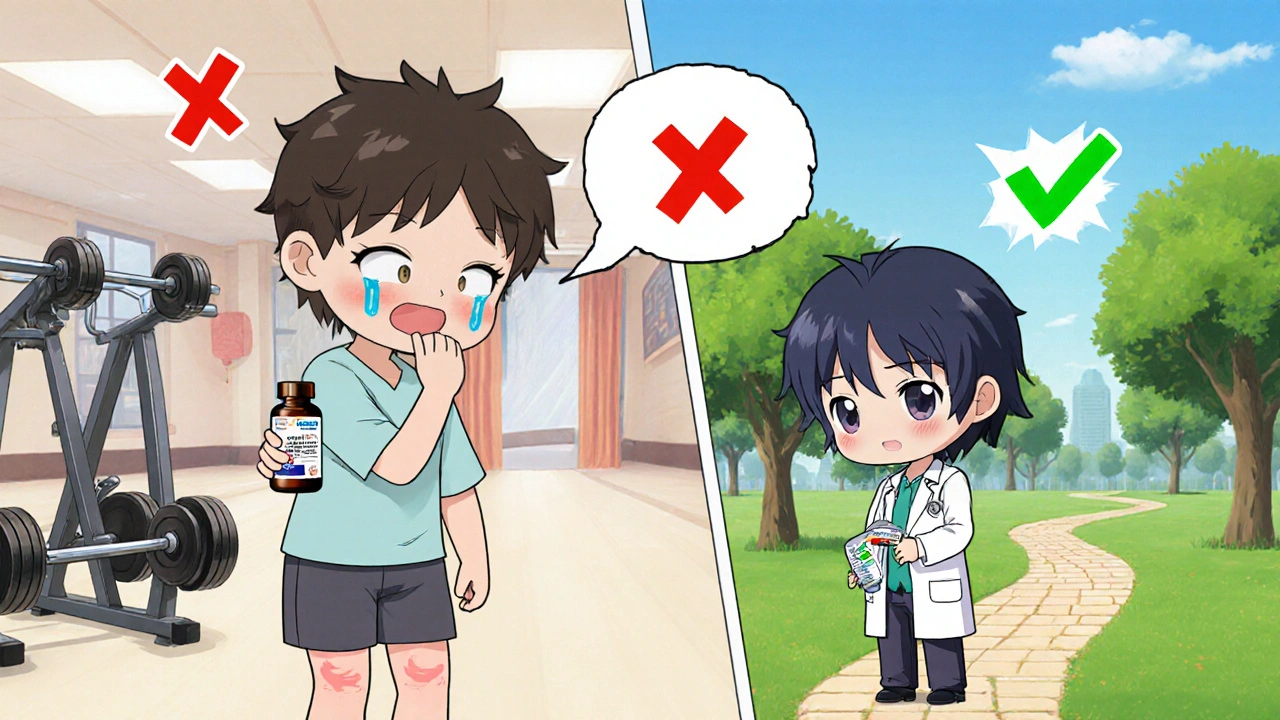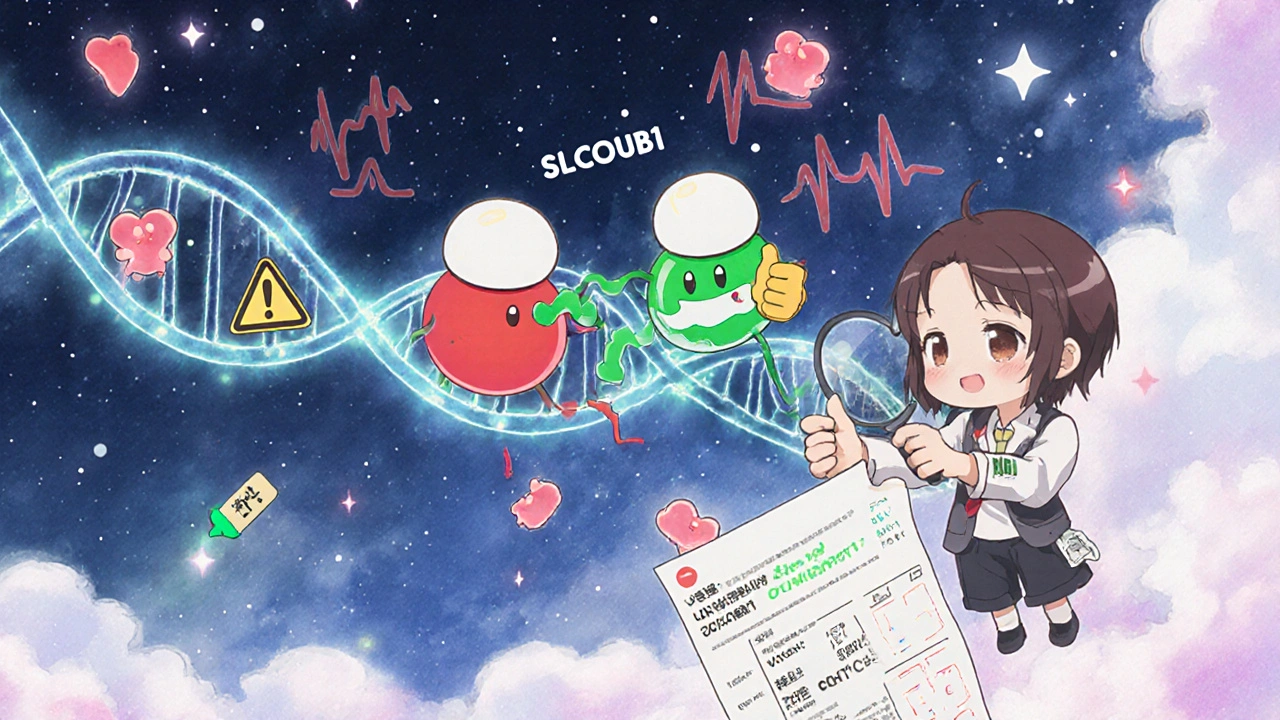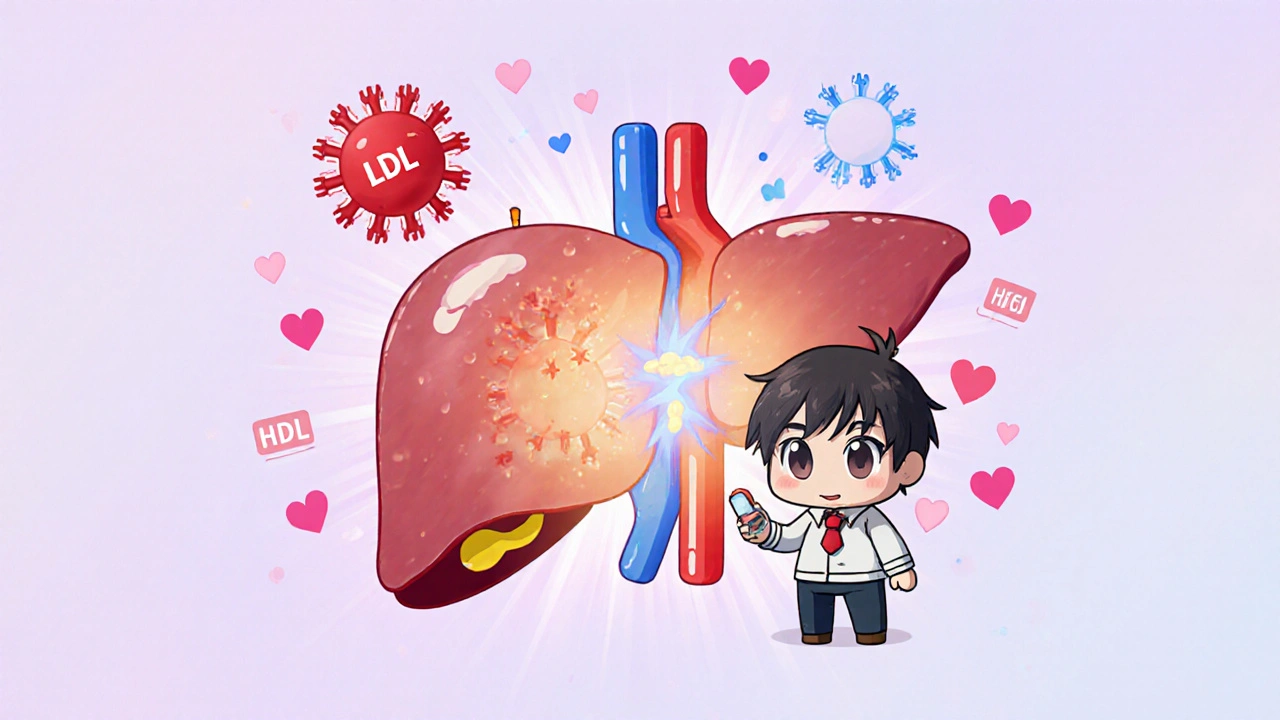For millions of people, statins are a daily pill that keeps their heart safe. But for others, that same pill brings aching legs, tired muscles, and sleepless nights wondering if the benefits are worth it. If you’ve been prescribed a statin-or are thinking about it-you’re not alone. And you’re not just guessing what’s going on. The science is clear: statins save lives. But they also come with real, common side effects that many doctors don’t talk about enough.
How Statins Actually Lower Cholesterol
Statins don’t just "lower cholesterol" like a magic trick. They work by blocking an enzyme in your liver called HMG-CoA reductase. That’s the enzyme your body uses to make cholesterol. When it’s blocked, your liver makes less cholesterol-about 75% of the cholesterol in your body comes from your liver anyway. So cutting that down makes a big difference.
Here’s what happens next: your liver notices it’s not making enough cholesterol, so it pulls more LDL (the "bad" kind) out of your blood to use as raw material. That’s why your LDL levels drop so dramatically. On average, statins lower LDL by about 1.8 mmol/L (70 mg/dL). That’s not a small number. It’s the kind of change that cuts your risk of a heart attack by up to 60% over time.
It’s not just about LDL, though. Statins also reduce inflammation in your arteries. They help stabilize plaque so it’s less likely to rupture and cause a clot. They improve how your blood vessels relax and function. These are called "pleiotropic effects"-side benefits that happen beyond just lowering cholesterol. That’s why even people with normal cholesterol but high inflammation still benefit from statins.
The Real Numbers: Who Benefits Most?
Not everyone needs a statin. The biggest gains go to people who’ve already had a heart attack, stroke, or have diabetes with high cholesterol. For them, the data is rock-solid: taking a statin reduces the chance of another major event by about 30%. That’s not a guess-it’s from studies like the Heart Protection Study and the 4S trial, which followed tens of thousands of people for years.
For someone with no history of heart disease but high risk (say, a 60-year-old with high blood pressure, smoking history, and LDL over 190), the benefit is still clear. For every 1 mmol/L drop in LDL, the risk of a major heart problem falls by about 22%. That’s why guidelines now recommend statins for people with a 10-year risk of 7.5% or higher.
But here’s the thing: most people who take statins don’t have a history of heart disease. In the U.S., about 39 million people are on them. Many are taking them because their doctor says "your cholesterol is high," not because they’ve had a heart attack. That’s where the conversation gets tricky. The benefit is real-but it’s smaller. For a low-risk person, taking a statin for five years might prevent one heart attack in every 100 people. That’s not nothing. But it’s also not a guarantee.
Muscle Pain: The Most Common Side Effect
Ask any pharmacist or doctor what the most common side effect of statins is, and they’ll say: muscle pain. Not always severe. Not always constant. But enough to make people stop taking them.
Studies show between 5% and 29% of people on statins report muscle aches, stiffness, or weakness. The American College of Cardiology says about 5% to 10% have muscle pain without any lab abnormalities (called myalgia). A smaller number-less than 0.1%-develop rhabdomyolysis, a rare but dangerous condition where muscle tissue breaks down and can damage the kidneys.
What does it feel like? People describe it like this:
- Legs feel heavy after walking
- Shoulders ache when reaching overhead
- Calves cramp at night
- General fatigue that doesn’t go away
It often starts after a few weeks or months. Some people think it’s just aging. Others blame their new gym routine. But if the pain goes away after stopping the statin-and comes back when you restart it-that’s a strong clue.
And here’s something many doctors don’t tell you: muscle pain from statins isn’t always about creatine kinase (CK) levels. You can have real muscle discomfort even if your blood test looks normal. That’s why doctors are starting to rely more on patient reports than lab numbers alone.

Why Do Statins Cause Muscle Pain?
It’s not fully understood, but science has some strong theories. One big one is that statins reduce levels of coenzyme Q10 (CoQ10), a compound your muscles need to make energy. Lower CoQ10 might mean less fuel for muscle cells, leading to fatigue and soreness.
Another theory involves a gene called SLCO1B1. Some people have a variant that makes it harder for their liver to clear certain statins-especially simvastatin. That means more of the drug builds up in the bloodstream, increasing the chance of muscle damage. If you’ve had muscle pain on one statin, switching to another might help. Pravastatin and fluvastatin are less likely to cause this problem.
Statins also affect how muscle cells repair themselves. They interfere with a process called prenylation, which helps cells send signals and stay healthy. When that’s disrupted, muscles can’t recover as well from normal wear and tear.
It’s not just the drug. Other things make muscle pain worse: intense exercise, alcohol, thyroid problems, vitamin D deficiency, and taking other medications like fibrates or certain antibiotics. Sometimes it’s a mix.
What to Do If You Have Muscle Pain
If you’re on a statin and feel muscle pain, don’t just quit. Talk to your doctor. Here’s what works:
- Try a different statin. Switching from simvastatin to pravastatin or fluvastatin often helps. Rosuvastatin and atorvastatin are also good options, though they can still cause issues.
- Lower the dose. Sometimes half a pill is enough. You might still get 80% of the heart protection with fewer side effects.
- Take it every other day. Some people do well on alternate-day dosing. It’s not for everyone, but it’s worth trying under supervision.
- Check your vitamin D. Low vitamin D is linked to muscle pain. Get tested. If you’re low, supplementing helps.
- Try CoQ10. Some studies show 100-200 mg daily reduces muscle symptoms. It’s not a cure, but it helps some people.
- Don’t overdo exercise. If you’re new to the gym or doing heavy lifting, dial it back. Statins + intense activity = higher risk.
And if your pain is severe, your urine turns dark, or you feel unusually weak-stop the statin and call your doctor right away. That could be rhabdomyolysis, and it needs quick treatment.

Are Statins Worth It for You?
This isn’t a one-size-fits-all decision. Ask yourself:
- Have I had a heart attack, stroke, or been diagnosed with heart disease?
- Do I have diabetes and high cholesterol?
- Am I over 50 with high blood pressure and a family history of early heart disease?
- Do I have muscle pain that started after I began taking the pill?
If you answered yes to the first three, the benefits almost certainly outweigh the risks. If you answered yes to the last one, you’re not weak-you’re reacting to a real biological effect.
There’s no shame in trying a different statin, lowering the dose, or even taking a break to see if your symptoms improve. Many people find a version that works. Others choose to manage cholesterol with diet, exercise, and other medications like ezetimibe or PCSK9 inhibitors.
And if your doctor dismisses your muscle pain as "just in your head"? Find a new one. Your experience matters.
What’s Next for Statins?
Scientists are working on smarter statins. New research from Stanford shows that statins protect blood vessel cells in ways we didn’t fully understand until recently. The goal now isn’t just to block cholesterol-it’s to keep the lining of your arteries healthy without hurting your muscles.
Some trials are testing lower doses combined with other drugs. Others are looking at genetic testing to predict who’s likely to have side effects before they start. In the future, you might get a simple blood test that tells you if simvastatin is risky for you.
For now, the best advice is simple: don’t assume statins are right for everyone. Don’t assume they’re all the same. And don’t assume muscle pain means you’re overreacting. The science supports both the benefits and the risks. The key is finding the right balance-for your body, your life, and your heart.
Do statins really prevent heart attacks?
Yes, for people at high risk, statins significantly reduce heart attacks and strokes. Large studies show a 30% reduction in major cardiovascular events. For someone who’s already had a heart attack, the benefit is even stronger. But for low-risk people, the absolute benefit is smaller-about one prevented event per 100 people over five years.
Can I stop taking statins if I feel fine?
Stopping statins means your cholesterol will likely rise again within weeks. For people with heart disease or diabetes, stopping increases the risk of another heart event. If you’re considering stopping because of side effects, talk to your doctor first. There are often alternatives-lower doses, different statins, or other medications-that can help you stay protected without the pain.
Is muscle pain from statins permanent?
No, muscle pain from statins is usually reversible. For most people, symptoms improve within days or weeks after stopping or switching the medication. In rare cases, it can take a few months for full recovery. If you stop and the pain goes away, and comes back when you restart, that’s a strong sign the statin was the cause.
Are natural alternatives as effective as statins?
Diet, exercise, and supplements like red yeast rice or plant sterols can lower cholesterol-but not as much or as reliably as statins. Red yeast rice contains a natural form of lovastatin and can cause similar side effects. For people at high risk, nothing replaces the proven protection of statins. For low-risk people, lifestyle changes may be enough, but they should be monitored with regular blood tests.
Why do some people have side effects and others don’t?
Genetics play a big role. A variant in the SLCO1B1 gene makes it harder for the body to clear certain statins, leading to higher levels in the blood and more muscle problems. Age, kidney or liver function, other medications, and vitamin D levels also matter. It’s not random-it’s biology. That’s why one person can take simvastatin for years with no issues, while another gets muscle pain after a few weeks.
If you’re on a statin and feel off, don’t ignore it. If you’re unsure whether you need one, ask for a risk assessment. Your heart deserves protection-but your body deserves respect too.

15 Comments
Conor McNamara
i think statins are just part of the pharmaco-corporate mind control. they dont want you healthy, they want you dependent. my legs hurt since i started taking it. coincidence? i think not. the docs all say its in my head. but i know better.
they dont tell you about the coq10 thing either. its all hidden. watch the videos on youtube.
Leilani O'Neill
This is precisely why the average person shouldn't be allowed to self-diagnose or self-manage their health. If you're taking a statin, you've already been assessed by a professional. Muscle pain is a minor inconvenience compared to dying of a myocardial infarction at 52. You're not special. Stop whining.
Riohlo (Or Rio) Marie
Oh darling, the real tragedy isn't the statin-it's the fact that your doctor didn't order a full lipid panel, check your Lp(a), test your vitamin D, or even bother to look at your SLCO1B1 genotype before prescribing simvastatin. You're not "sensitive," you're just statistically predictable. And now you're part of the 29% who got lazy medicine. Pathetic.
steffi walsh
i felt the same way when i started. but i switched to pravastatin, took 100mg coq10, and got my vit d checked-it was 18. now i feel like a new person. you're not broken, you just need the right fit.
you got this 💪
Denny Sucipto
man i was on simva for 3 years and my quads felt like concrete. switched to rosuvastatin at half dose, started walking every day, and boom-no pain, my ldl dropped to 68. you’re not weak. you’re just not on the right one. talk to your doc. don’t quit cold.
Holly Powell
The anecdotal reporting of myalgia is confounded by the nocebo effect, particularly in populations with high health anxiety and low numeracy. The absolute risk reduction in cardiovascular events is statistically significant and clinically meaningful in primary prevention cohorts with a 10-year ASCVD risk ≥7.5%. Your discomfort does not invalidate population-level benefit.
Emanuel Jalba
I DIDN'T ASK FOR THIS 😭 I JUST WANTED TO EAT MY BURGER IN PEACE 🍔
THEY PUT STATINS IN THE WATER NOW I KNOW IT 😡 I SAW IT ON A TIKTOK 🚨 MY LEGS ARE ON FIRE 🔥 MY DOCTOR IS A ROBOT 🤖 I'M NOT TAKING IT ANYMORE 🙅♂️
Heidi R
You're not entitled to your own biology. If you're high risk, you take the statin. If you can't tolerate it, you get ezetimibe or a PCSK9i. Stop treating your discomfort like a moral victory. It's not noble. It's just ignorant.
Brenda Kuter
I used to think statins were safe until my neighbor died from rhabdo. She was 68, took simva, drank wine, and lifted weights. They told her it was "just muscle pain." She collapsed in the grocery store. They didn't even test her CK. Now her husband posts on Reddit every day. I'm not taking it. I'd rather die than be a statistic in a drug trial.
Shaun Barratt
The data presented in this article is methodologically sound and aligns with current guidelines from the American College of Cardiology and the European Society of Cardiology. The prevalence of myalgia is context-dependent and influenced by genetic, pharmacokinetic, and behavioral variables. The recommendation to consider alternative statins or dosing regimens is clinically prudent and evidence-based.
Iska Ede
So let me get this straight. You're telling me I can't have a nice steak dinner without being forced to take a pill that turns my legs into spaghetti? And if I complain, I'm "ignorant"? Sweetheart, I didn't sign up for this. I'm not a lab rat.
Gabriella Jayne Bosticco
I’ve been on statins for 12 years. Had muscle pain at first. Switched to fluvastatin. Took CoQ10. Cut back on red meat. Now I feel better than I did in my 30s. It’s not magic. It’s adjustment. You don’t have to suffer. You just have to be patient and persistent.
Sarah Frey
It is important to recognize that individual experiences with statin therapy vary widely. While population-level data supports the efficacy and safety profile of statins in indicated populations, patient-reported outcomes remain a critical component of clinical decision-making. A collaborative, patient-centered approach is essential.
Katelyn Sykes
if your legs hurt try lowering the dose first dont just quit. also vitamin d is huge. mine was low and i felt like a zombie. took 5000iu for a month and boom energy back. coq10 helps too. not a cure but it helps. dont be scared to talk to your doc
Gabe Solack
statins saved my life after my stent. but i had muscle pain too. switched to pravastatin, took coq10, and stopped doing heavy squats. now i hike 5 miles every weekend. it’s not perfect, but it’s worth it. you’re not alone. talk to someone who gets it 💙